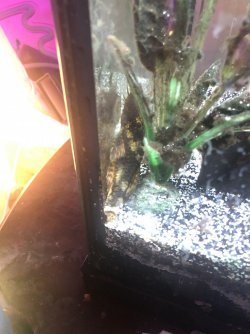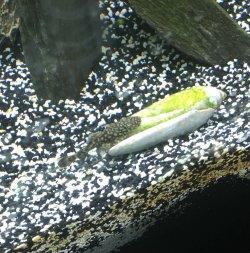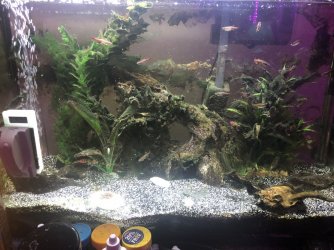You are using an out of date browser. It may not display this or other websites correctly.
You should upgrade or use an alternative browser.
You should upgrade or use an alternative browser.
Bristlenose pleco morph?
- Thread starter Jahvfish
- Start date
The April FOTM Contest Poll is open!

🏆 Click to vote! 🏆
wow he's amazingI know that I have a bristlenose pleco, but I was wondering if he had a specific morph with a name to it. He doesn’t look like the standard bristlenose to me… thank you!
whered you get him?
found it: calico bristlenose
edit: not sure idk
It might be the sun light shining on the fish.
You have a lot of blue green algae (Cyanobacter bacteria) on the plant in the picture. That can be caused by too many nutrients (especially from dry food), low oxygen levels, lack of water movement, a dirty tank, or an incorrect light colour spectrum (it loves red light).
You can try doing a big (75%) water change and gravel cleaning the substrate every day for a few weeks. Try to physically remove as much of the blue green algae as possible.
Make sure any new water is free of chlorine/ chloramine before it's added to the tank.
Increase water movement and aeration.
Stop adding fertiliser (assuming you add any) for a month.
Make sure the light has a Kelvin rating around 5500-6500K.
You have a lot of blue green algae (Cyanobacter bacteria) on the plant in the picture. That can be caused by too many nutrients (especially from dry food), low oxygen levels, lack of water movement, a dirty tank, or an incorrect light colour spectrum (it loves red light).
You can try doing a big (75%) water change and gravel cleaning the substrate every day for a few weeks. Try to physically remove as much of the blue green algae as possible.
Make sure any new water is free of chlorine/ chloramine before it's added to the tank.
Increase water movement and aeration.
Stop adding fertiliser (assuming you add any) for a month.
Make sure the light has a Kelvin rating around 5500-6500K.
I actually got him at petsmart almost 3 years ago. Him as a baby… he’s about 4 1/2 inches long nowwow he's amazing
whered you get him?
found it: calico bristlenose
edit: not sure idk
Attachments
I’m in the process of cleaning up the tank. I have to admit I did let it go for some time. I’ve started treating the blue green algae with ultra life blue green algae stain remover. I’ve done numerous water changes throughout the past couple weeks. Water parameters are good. I also added an air stone recently. This is what it looks like currently. I wish I had a before photo to show you. Not a proud moment, but it’s getting there.It might be the sun light shining on the fish.
You have a lot of blue green algae (Cyanobacter bacteria) on the plant in the picture. That can be caused by too many nutrients (especially from dry food), low oxygen levels, lack of water movement, a dirty tank, or an incorrect light colour spectrum (it loves red light).
You can try doing a big (75%) water change and gravel cleaning the substrate every day for a few weeks. Try to physically remove as much of the blue green algae as possible.
Make sure any new water is free of chlorine/ chloramine before it's added to the tank.
Increase water movement and aeration.
Stop adding fertiliser (assuming you add any) for a month.
Make sure the light has a Kelvin rating around 5500-6500K.
Attachments
take the plants out and hose them off. If they are plastic plants, hose them, them soak in bleach for 15 minutes, then hose again. Then soak in a bucket of tap water with a triple dose of dechlorinator.
That certainly is on my list of things to do. I just didn’t want to do too much at one time, so I’ve been cleaning it at over time.take the plants out and hose them off. If they are plastic plants, hose them, them soak in bleach for 15 minutes, then hose again. Then soak in a bucket of tap water with a triple dose of dechlorinator.
Ancistrus (bristlenoses) are a complicated family with a lot of similar looking species. The trade names, like Calico, really depend on where you are, who is selling a fish and if they can invent a name that sells. The scientific name is hard to track without knowing where the fish originated - not which farm but which river or country... That is impossible to find out.
I'd call him a Handsome Ancistrus sp., and leave it at that. Whatever his real name is, he's a nice looking healthy well cared for fish.
I'd call him a Handsome Ancistrus sp., and leave it at that. Whatever his real name is, he's a nice looking healthy well cared for fish.
oh dang,,, submerged duckweed?With blue green algae, you need to clean as much out as possible because it can double its size every day.
Personally, I love the diversity with these fish, and if it means we don't know what we have, or the same English trade name is used for a bunch of different, similar fish, so be it. They're ancistrus, and they're wonderful, but there aren't breed standard type names because it's such a nightmare to even sort out which species they are.
Look
s Like a calico bristlenoseI know that I have a bristlenose pleco, but I was wondering if he had a specific morph with a name to it. He doesn’t look like the standard bristlenose to me… thank you!
Latest Discussions
- Replies
- 0
- Views
- 7




